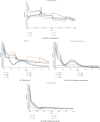Green Synthesis of Silver Nanoparticles Using the Tridax procumbens Plant Extract and Screening of Its Antimicrobial and Anticancer Activities
- PMID: 35795854
- PMCID: PMC9252769
- DOI: 10.1155/2022/9671594
Green Synthesis of Silver Nanoparticles Using the Tridax procumbens Plant Extract and Screening of Its Antimicrobial and Anticancer Activities
Abstract
In this study, we report the green synthesis of silver nanoparticles (AgNPs) using the aqueous leaf extract of Tridax procumbens (TNP), which acts as the source of the reducing and capping agent. The distinctive absorption at 370 nm suggested synthesis of TNPs, which was confirmed by TEM, with a size in the range of 11.1 nm to 45.4 nm and a spherical shape, having a face-centered cubic structure, analyzed by XRD, and a Zeta potential of -20.7 mV, which indicated a moderate stability of TNP. The FTIR analysis revealed the presence of amines and hydroxyl groups with fluoro compounds over the TNPs. The HRLC-MS analysis of TNPs suggested the presence of a major capping agent such as fosinopril and reducing agents such as peptides (Gln Gly Ala, Ser Pro Asn, and Leu Met), terpenoids (lupanyl acid, tiamulin), polyphenol (peucenin), and alkaloids (8',10'-dihydroxydihydroergotamine, carteolol). The synthesized silver nanoparticles exhibited antimicrobial activity against multidrug-resistant (MDR) clinical isolates (Escherichia coli, Shigella spp., Aeromonas spp., Pseudomonas aeruginosa, and Candida tropicalis) and had anticancer activity against A459 (IC50 42.70 μg/ml). The extraction of partially purified aqueous leaf extracts by silica gel column chromatography followed by HPLC to synthesize silver nanoparticles (TNP11) and analyzed by HRLC-MS suggested that dipeptides were involved in the reduction of Ag+ to Ag0. Overall, the results showed that the green silver nanoparticles of T. procumbens could be safe, as they are endowed with potential antimicrobial activity against MDR clinical isolates and human lung carcinoma cells.
Copyright © 2022 Rohini Pungle et al.
Conflict of interest statement
The authors declare that no competing interest exists with this manuscript.
Figures







References
-
- Abalkhil T. A., Alharbi S. A., Salmen S. H., Wainwright M. Bactericidal activity of biosynthesized silver nanoparticles against human pathogenic bacteria. Biotechnology & Biotechnological Equipment . 2017;31(2):411–417. doi: 10.1080/13102818.2016.1267594. - DOI
MeSH terms
Substances
LinkOut - more resources
Full Text Sources
Miscellaneous

